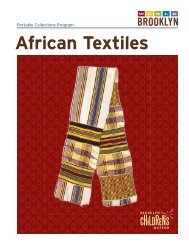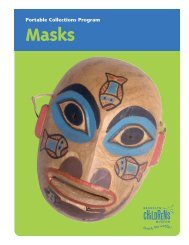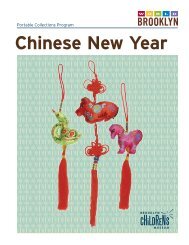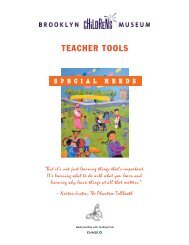Telling Stories Through Objects - Brooklyn Children's Museum
Telling Stories Through Objects - Brooklyn Children's Museum
Telling Stories Through Objects - Brooklyn Children's Museum
Create successful ePaper yourself
Turn your PDF publications into a flip-book with our unique Google optimized e-Paper software.
■ INFORMATION FOR THE TEACHER ■<br />
Information About the <strong>Objects</strong> in the Case (continued)<br />
the present day. They are one of China’s many<br />
unique inventions, and countless writers and artists<br />
have used them to create great works of literature<br />
and art. See the story “The Dreaming Prince,” page 32.<br />
SHADOW PUPPET (Object No. 75.16.2)<br />
Indonesia (Java), 1970s<br />
Puppet performance is a type<br />
of theater common in many<br />
Southeast Asian countries.<br />
Each country or region has its<br />
own traditions and a unique<br />
style of puppets. In Indonesia,<br />
these performances are put<br />
on with shadow puppets<br />
called wayang kulit. Many puppet performances tell<br />
stories of Hindu or Islamic heroes and legends. They<br />
may be performed for many different purposes, such<br />
as to celebrate a wedding or observe the anniversary<br />
of a funeral. Wayang plays captivate children and<br />
adults alike, teaching them about their heritage and<br />
affirming the moral and cultural values of<br />
Indonesian society. Read the book Rama and Sita: A<br />
Tale from Ancient Java provided in the case.<br />
Wayang kulit are made from animal skins decorated<br />
with gold leaf and paint. The dalang (puppeteer)<br />
supports the puppet with a wooden rod attached to<br />
the body, while two smaller rods attached to the<br />
hands allow the puppets to express a wide range of<br />
gestures and emotions. Plays are performed behind<br />
a transparent screen backlit with small lamps. A<br />
typical dalang might have between 100 and 300<br />
shadow puppets in his set. The costumes, hairdos,<br />
facial features, and colors of the puppets identify the<br />
standard characters they represent, from princesses<br />
and warriors to clowns and scheming courtiers, and<br />
even the gods themselves. For example, this puppet<br />
is a female figure whose gold face and body represent<br />
either dignity or youth. Her refined features<br />
indicate that she is an aristocratic or morally good<br />
character, but the story that goes with her is<br />
unknown. She might be used to represent Sita, wife<br />
of Prince Rama, the hero of the Ramayana, a very<br />
long and very old Indian poem.<br />
TELLING STORIES THROUGH OBJECTS 7<br />
KIWI FIGURE (Object No. 2006.15)<br />
The kiwi is a small, flightless<br />
bird that lives in the forests,<br />
grasslands, and swamps of<br />
New Zealand. It is a beloved<br />
national symbol of that country,<br />
whose residents commonly<br />
refer to themselves as kiwis.<br />
The kiwi is also a prominent<br />
character in the mythology of the Maori people<br />
(native new Zealanders). According to many Maori<br />
traditions, kiwis are the oldest members of the bird<br />
family, so they are, in effect, our older siblings. Kiwis<br />
are said to be very protective of humans, which is<br />
why they patrol the forests each night. See the story<br />
“How the Kiwi Lost Its Wings,” page 36.<br />
BARK PAINTING (Object No. 65.52.4)<br />
Australia, about 1964<br />
The aboriginal peoples of<br />
Arnhem Land (an area of<br />
northern Australia) paint<br />
pictures on bark cut from the<br />
eucalyptus tree. Using paintbrushes<br />
made of human hair<br />
or twigs with chewed ends,<br />
the artist works in shades of<br />
black, red, yellow, and white with paints made from<br />
ground-up minerals. This painting was made by a<br />
man from the Ingura tribe, and depicts a group of<br />
men dancing next to the fish they have speared.<br />
Any Ingura man may paint pictures of non-religious<br />
activities such as hunting, fishing, or historical events.<br />
The Ingura people hang these paintings inside their<br />
homes and use them to educate young people about<br />
hunting and fishing practices, ancient feats, and<br />
traditional stories. The Ingura also create secret,<br />
sacred paintings depicting the ancient spirits of their<br />
creation story.<br />
There is no specific story to go with this object.<br />
Students can make up their own, or do research and<br />
write a report on aboriginal people and their lives.








